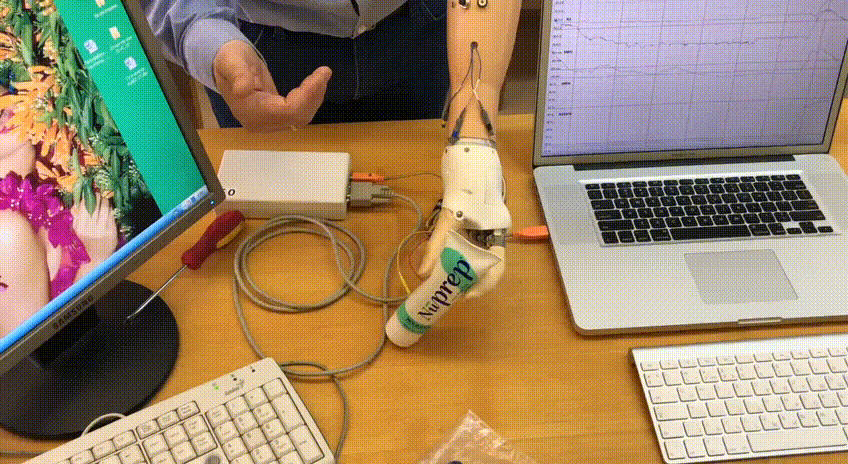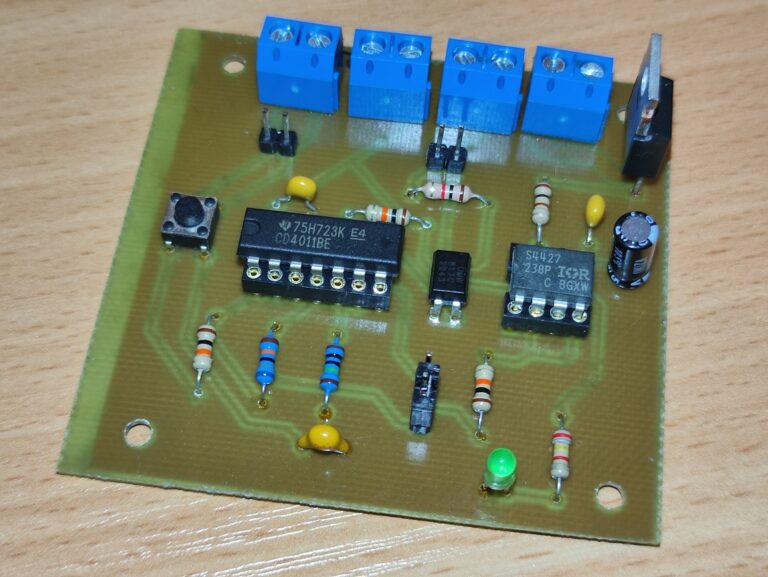Forearm prosthesis – how Bauman scientists turn thoughts into actions
There are three types of prostheses.
- Myoelectric prostheses are prostheses that are controlled by signals generated by muscle contraction. These contractions are read using electromyographic (EMG) sensors. You can also find another name for myoelectric prostheses – bionic or bioelectric with an external energy source.
- Cosmetic prostheses are uncontrollable prostheses that perform only a decorative function.
- Traction prostheses – prostheses in which control is carried out by means of rods and are completely controlled by the efforts of the person himself without any electronics. Such prostheses allow the artificial hand to be compressed due to the mechanical traction of the opposite shoulder (stretching – weakening the cable).
At present, in Russia, up to 7 thousand patients are annually prosthetic with upper limb prostheses. Basically, these are cosmetic or traction prostheses with the simplest function of gripping the hand. Abroad, the share of myoelectric prostheses, in which the electrical potentials of antagonist muscles are the source of control signals, is 50%, in our country it is only 2-3%.
Muscles-antagonists are two muscles (or two muscle groups) of one joint, which, when contracted, pull in opposite directions. Flexion of the forearm is performed by the biceps brachii muscle, and extension of the forearm is performed by the triceps muscle of the shoulder. These two muscles are antagonistic muscles because they pull in opposite directions relative to the elbow joint. One muscle (biceps brachii) is responsible for flexion, and the other (triceps brachii) is responsible for extension.
Bionic prostheses have not gained popularity in Russia, as they are very expensive. Moreover, visually, such a device is a collection of metal connections and wires, while cosmetic processes almost exactly repeat the image of a human hand. In addition, there are not many specialists in the country who could properly adjust this type of prosthesis: make the necessary impressions, place sensors.
It should also be borne in mind that the possibilities of myoelectric control of the prosthesis are limited by the level of amputation, i.e. the number of remaining functioning muscles. For the rehabilitation of patients with arm amputation above the elbow, the use of myoelectric control is impractical. In such cases, neuroprostheses (brain-computer interface) or Target Muscle Reinnervation (TMR) technology are used. The TMR method consists in the fact that the nerves that were previously responsible for the functional actions of the hand are brought to other muscles preserved after the amputation, and from them sensory sensors receive the signal and send it to the processor that controls the electric motors that set the prosthesis in motion.

How dentures work
When developing bio- or neurocontrolled biotechnical devices, first of all, it is necessary to determine the method of obtaining information about the movement being performed. In modern biotechnical means such as human-computer interaction systems (Human Computer Interaction – HCI), biosignals are used: electroencephalograms (EEG), electromyograms (EMG), electroneurograms (ENG), electrooculograms (EOG).
The most widespread is the use of electromyogram.
It is myoelectric prostheses that make it possible to control various functional movements. For example, in modern commercial forearm prostheses, the patient can control two movements (grip and rotation) and control the speed of their execution. However, even these simple movements need to be learned, for this a program of eight lessons has been developed, where they study “their new body” and try to use it.
The onset of muscle contraction is initiated by electrical impulses in the nerve trunks that enter the muscle fibers. These impulses depolarize the membrane of muscle cells, as a result of which an action potential is created in the muscle fibers, which quickly spreads along the nerve fiber and leads to its contraction. Moreover, the reduction is only initiated by this action potential, and the reduction process itself is much longer. Using needle (invasive) or surface electrodes, it is possible to register the sum of the action potentials of all cells involved in the process.

To perform the “grasp-open” function, it is necessary to bend-unbend the hand. That is, the control of the prosthesis is not natural (anthropomorphic) and additional patient training will be required, which takes weeks. The actuator moves “from edge to edge” without intermediate positions – this is due to the fact that the EMG signal does not reflect the mechanical parameters of muscle contraction. The only thing that the patient can control is to proportionally control the speed of the movement.
Lack of existing methods
The disadvantage of all known methods of electromyographic control of prostheses is that depolarization signals from simultaneously stimulated muscles are superimposed, therefore it is extremely difficult to receive an EMG signal about the activity of a particular muscle. In addition, the influence of crosstalk (interference) noise from adjacent muscles increases with increasing distance between the measuring electrodes.
Switching between the two movements is done mechanically or with a hidden switch. If there are many functions – special coding in Morse code or RFID tags, pasted throughout the apartment.

The global task facing scientists all over the world is to achieve cross-classification, i.e. provide the ability to simultaneously grip / open and rotate without auxiliary switching.

The development team of the BMT-2 Department of Biomedical Technology at Moscow State Technical University was faced with the same task – to implement control of two movements (grip and rotation of the hand), but at the same time to achieve not only proportionality of control, but to maintain the anthropomorphism of these movements. Anthropomorphism is understood as the execution of precisely those movements that the patient thinks about in real time. Bauman scientists are engaged in this task – employees of the BMT-2 department.
Development and its features
The technical objective of the present invention is to provide the possibility of obtaining a high-quality and stable signal, which, when controlled by a technical device, allows to form control actions proportional to the degree of muscle contraction with a delay of no more than 120 ms.
To solve this problem, the developers applied a combined approach, the essence of which is the joint registration of an electromyogram and the active component of electrical impedance from a single electrode system. Electrical impedance myography is based on the measurement of changes in the electrical impedance of muscles that occur during muscle contractions.
An alternating current of a stable amplitude is supplied to the probing electrodes, and the voltage is recorded from the measuring electrodes, which, after frequency separation of the channels, is converted into EMG and the active resistance of the body area, reflecting the process of mechanical muscle contraction. It has been experimentally established that muscle contraction leads to a proportional change in active resistance recorded in the projection of this muscle.

Prosthesis manufactured by PJSC RSC Energia
Principle of operation
The technical result in this case is to provide the possibility of obtaining a control signal based on the registration of muscle contraction in time.
In this case, it became possible to track, register and turn into a control signal “the very movement of the muscle” in time, while the known methods of removing biopotentials from a muscle using myo-sensors, only record the beginning of contraction.
For control, two electrode systems are used, which are located on the stump in the projection of the antagonist muscles, just like in a myoelectric prosthesis. Thus, the established prosthetics technology is not violated.
An electrical impedance signal is used as an electrophysiological signal.

The upper figure shows the synchronous registration of an electrophysiological signal – electrical impedance and an electromyogram (EMG) signal from electrodes located on the surface of the skin above the flexor muscle of the fingers when performing the “hand grip” movement. The developers of MSTU managed to achieve such a clear signal that it makes it possible to achieve the possibility of performing anthropomorphic movements.

To implement the method, the authors have developed a block diagram of the device shown above, where TE is a current electrode, IE is a measuring electrode, and MT is a measuring transducer.
The authors also developed electrode systems, which are a base (made of rubber or plastic), on which four electrodes are fixed. Through these electrodes, current is supplied (current electrodes), and the voltage is measured as the potential difference between the electrodes (potential electrodes). This method is implemented in accordance with the structural diagram presented below.

The EMG signal is separated from the electrical impedance signal by a bandpass filter with a bandwidth of 50 Hz to 400 Hz (EMG channel filter). The amplitude-modulated electrical impedance signal is separated from the EMG signal by a bandpass filter with a passband of 10 kHz to 1 MHz (impedance channel filter) and detected by a synchronous detector. To operate the synchronous detector as the carrier of the reference frequency, the microprocessor generates the same reference signal as for the corresponding current source. After additional amplification, both channels are digitized by an analog-to-digital converter (ADC). This is how a control signal is received from one muscle.
However, in order to obtain a better and more stable control signal for a technical device, the second channel of the device should be used, which, working in a similar way, registers the electrical impedance signal and the EMG signal from the second muscle – the antagonist muscle.
To eliminate the mutual influence of the two electrical impedance channels, phase or time separation of the channels is used.
One of the possible options for using the proposed method is a device for bionic control of a hand prosthesis, which consists of: two tetrapolar electrode systems; two-channel impedance measuring transducer; processing unit; control unit and actuator – hand prosthesis, as shown in the figure.

This approach without alterations can be used not only to control the upper limb, but also the lower one.

Further perspectives
A further direction of research in this area is the implementation of complex anthropomorphic movements (for example, simultaneous gripping and rotation of the hand). At the same time, the number of electrode systems and the area of their location should remain the same so as not to disrupt the established prosthetics technology.






